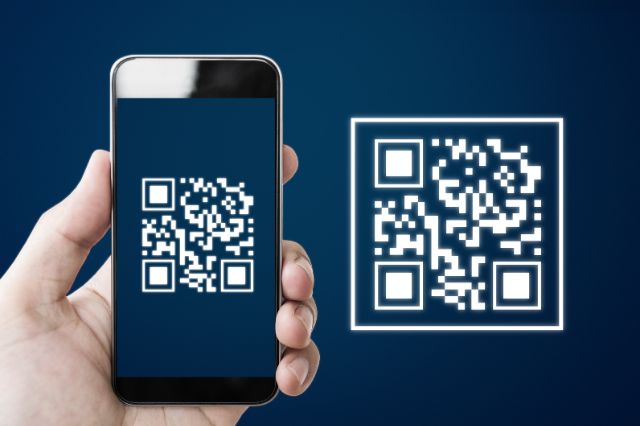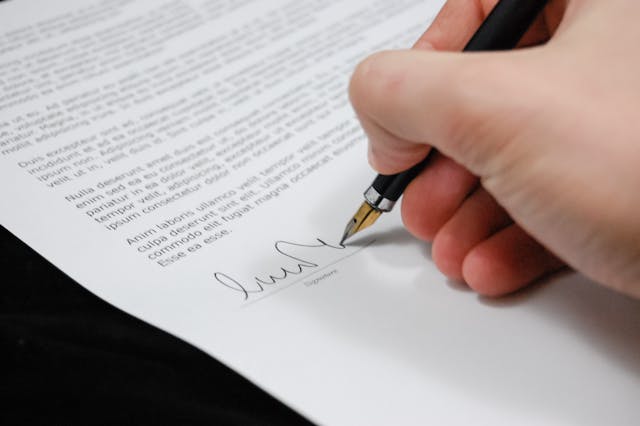Business
Innovative Solutions: Harnessing QR Codes for Effective Foodservice Management


The world of food service is constantly evolving, and technology plays a pivotal role in shaping its landscape. QR codes are a versatile and efficient solution among the tech tools that have a significant impact.
This article aims to delve into the multifaceted role of QR codes in revolutionizing food service management, exploring their definition, benefits, implementation strategies, challenges, future trends, and transformative potential.
- Definition and Introduction to QR Codes in Foodservice
At its core, a QR code, or Quick Response code, is a two-dimensional barcode that can store a wide range of information. Initially designed for inventory tracking in the automotive industry, QR codes have swiftly entered various sectors, including foodservice.
- Understanding the Role of QR Codes in Enhancing Foodservice Management
The primary goal of this article is to dissect the significance of QR codes within foodservice, emphasizing their role in optimizing operations, enhancing customer experience, and addressing post-pandemic safety concerns.
Understanding QR Codes in Foodservice
- What are QR Codes?
Quick Response codes, or QR codes for short, are two-dimensional barcodes that can transmit and retain data. QR codes were first created in Japan to track car parts. Still, they have since expanded into a flexible tool utilized in many different industries, including the foodservice industry.
These codes can hold various kinds of data, including text, URLs, contact details, and other digital content. They are made up of black squares organized on a white background. Smartphones and other gadgets with cameras and QR code reading software can quickly scan them thanks to their unique layout.
In foodservice, QR codes have emerged as a modern solution to address multiple operational needs, including menu access, order processing, payment, customer engagement, and more.
Their ease of use and adaptability make them valuable for streamlining processes and enhancing customer experiences in restaurants, cafes, food trucks, and various dining establishments.
- Evolution and Adoption of QR Codes in the Food Industry
The evolution of QR codes within the food industry reflects a remarkable journey from their initial usage as inventory tracking tools to becoming integral components of food service operations.
Initially gaining traction in Asian markets, QR codes gradually expanded their presence worldwide, especially with the increasing ubiquity of smartphones and technological advancements.
Their adoption within the food industry accelerated due to several factors, including the need for contactless solutions during the COVID-19 pandemic, the growing emphasis on enhancing customer experiences, and the drive for operational efficiency.
Restaurants and foodservice businesses swiftly recognized the potential of QR codes in addressing these needs, leading to their widespread integration into various aspects of the industry.
Benefits of QR Codes in Foodservice Management
- The Simplicity of QR Code Creation
One of the standout advantages of QR codes, particularly in the food service industry, is the straightforward and user-friendly process involved in their creation. This simplicity empowers businesses of all sizes to effortlessly incorporate these codes into their operations.
A wide array of online platforms and mobile applications designed explicitly for QR code generation exists. These platforms offer intuitive interfaces, enabling users to create a QR code for a URL easily.
Inputting various data types such as URLs, text, contact details, or other information is a hassle-free process within these platforms.
The customization options provided by these tools are a key feature. Businesses can tailor their QR codes by incorporating branding elements like logos, colors, or designs, ensuring consistency with their visual identity and enhancing recognition.
Typically, the creation process involves a few simple steps: selecting the content type to be encoded, inputting the desired information, and optionally customizing the appearance of the QR code.
Once generated, these codes are readily available for download in multiple formats, ensuring compatibility across various marketing materials, menus, or digital platforms.
- Enhanced Customer Experience: Ordering and Menu Accessibility
QR codes revolutionize the dining experience by simplifying the ordering process and granting patrons convenient access to menus, ultimately elevating customer satisfaction. By seamlessly integrating QR codes into the dining environment, customers can effortlessly access menus by scanning codes placed on tables, menus, or promotional materials.
This eliminates the need for physical menus, reduces paper waste, and allows for real-time product updates or modifications. The ease of access and comprehensive information provided through QR-enabled menus empower customers to make informed choices and accommodate dietary preferences or special requests.
Consequently, this streamlined approach expedites ordering, minimizes waiting times, and enhances overall dining experiences, contributing significantly to customer contentment and loyalty.
- Operational Efficiency: Streamlining Processes and Inventory Management
QR codes are pivotal in streamlining operational processes and optimizing food service inventory management. These codes are efficient tools for simplifying various tasks, including order processing, inventory tracking, and logistical operations.
By integrating QR codes into inventory systems, restaurants and food businesses gain real-time visibility into stock levels, enabling accurate monitoring of product movements and reducing the likelihood of errors or discrepancies. This heightened efficiency translates to reduced waste, optimized stocking levels, and improved inventory turnover rates.
Moreover, QR codes facilitate precise tracking of expiration dates, ensuring that perishable items are managed effectively, thereby minimizing food wastage and maximizing operational efficiency.
- Contactless Payments and Safety Measures in the Post-Pandemic Era
In response to the heightened need for safety measures in the post-pandemic era, QR codes emerge as instrumental tools in facilitating contactless payments and ensuring the safety of both customers and staff.
With the increased emphasis on hygiene and limited physical contact, QR codes enable customers to make secure and contactless payments through their smartphones or mobile payment platforms.
By scanning a QR code displayed at checkout, customers can complete transactions without handling cash or physical cards, reducing the risk of potential viral transmission. This contactless payment method aligns with health protocols and instills confidence in patrons, fostering a sense of safety and reassurance while dining out.
- Marketing and Promotional Opportunities Through QR Code Integration
QR codes present many opportunities for foodservice businesses to engage in effective marketing campaigns and promotional activities. These codes are versatile marketing tools, allowing establishments to link customers to exclusive offers, discounts, loyalty programs, or promotional content.
Businesses can connect seamlessly with their target audience by strategically placing QR codes on marketing materials, receipts, or physical products, driving engagement and brand loyalty. QR codes also facilitate tracking customer interactions, providing valuable data insights businesses can leverage to tailor marketing strategies and enhance customer relationships.
This direct and interactive engagement enhances brand visibility and fosters a more personalized and engaging customer experience, bolstering customer retention and attracting new clientele.
Conclusion
Integrating QR codes emerges as a transformative and indispensable tool in the dynamic realm of foodservice. Throughout this exploration, the multifaceted role of QR codes in revolutionizing foodservice management has been unveiled.
From their origins as inventory tracking tools to integral components within the food industry, QR codes have evolved significantly, becoming catalysts for operational efficiency, enhanced customer experiences, and innovative marketing strategies.
The seamless accessibility afforded by QR codes in ordering processes and menu navigation has expedited service and heightened customer satisfaction. Their instrumental role in streamlining operational processes, optimizing inventory management, and facilitating contactless payments has not gone unnoticed, revolutionizing safety measures in the post-pandemic era.
Moreover, QR codes have opened new avenues for foodservice businesses to engage with their patrons through personalized marketing initiatives, driving customer loyalty and fostering brand connections.
As the foodservice industry continues to evolve, the transformative potential of QR codes remains undeniably influential. Their adaptability and versatility offer a glimpse into a future where technology intersects seamlessly with dining experiences, promising greater efficiency, safety, and engagement for businesses and customers.
Business
How to Launch a Successful Photography Business


Having a photography business is a wonderful way to pursue your passion for photography and make money at the same time. You could set your own hours, travel, and do meaningful work. Of course, setting up a successful business can take some doing.
The competition in the photography niche is stiff, clients notoriously demanding, and the income unsteady – at least in the beginning.
To maximize your chances of success, check out this mini-guide on setting up your very own – profitable – photography business:
Make Sure You are Mentally and Emotionally Prepared
If you’re serious about making money from photography, you’d do well to treat it as a business as opposed to a side gig. That way, you’ll value and monetize your work appropriately in a way that allows you to sustain yourself long-term.
Running a business requires a great deal of patience, planning, and business-related work, from administration to customer management. It can also be risky. Are you mentally prepared?
Research the Market and Pick a Specialization
Market research is crucial to success. How much are people willing to pay for photographers in your area? What kind of photography is the most lucrative? Who are your competitors, and what are they doing?
Understanding your ideal customers allows you to figure out the best way to serve their needs and, by extension, get paid well for your work. You should, ideally, pick a specialization that’s in high demand and aligns with your preferences and existing skills. Some examples are event photography, nature photography, and wedding photography.
Consider Brushing Up on Your Photography Skills
Taking a photography class could be well worth your time. You can explore different specializations and find one that works for you. Furthermore, you can pick up and hone key photography skills, gain feedback for your work from experts, explore the latest technology, and understand how to be a professional photographer.
Create a Business Plan
Creating a photography business plan is difficult and time-consuming but well worth it in the end. This document can give you clarity on the specific steps you need to take to set up your business.
It details your business model, monetization strategy, market conditions, funding, operational expenses, financial projections, and business goals. Additionally, you could use this document to attract investors if necessary.
Choose a Business Structure, such as an LLC
Having a business structure can simplify some aspects of running your business, make you seem more professional, and safeguard you against risk.
For instance, setting up an LLC protects your personal assets against lawsuits and offers some advantages like tax-related benefits and flexibility. You can file the LLC paperwork yourself, hire an (expensive) lawyer, or use an online LLC formation service.
Get Set Up
It’s time to get up and running. Start by taking care of the legalities such as registering with the government, acquiring licenses or permits, getting insured, getting an EIN, and more. Get all your work equipment in order and find a suitable location for your business.
Next, set up your work processes – how you’ll be offering your services to your ideal customer – using your business plan as a roadmap. You will also need to see to the administrative details such as bookkeeping and billing. You can use software to make this easier.
Finally, you’ll need somewhere to work. Running a business out of your home can be very cost effective, but you need to have enough space for your equipment along with a home office or even a dark room.
Brand and Market Your New Business
Good marketing is often the difference between success and failure for businesses. Creating a meaningful brand – whether that’s around you personally or your business – can make you memorable and help you build meaningful relationships with customers.
Offline and online marketing can help you find new leads and retain existing ones. Using an Instagram scheduler can streamline your social media efforts, ensuring consistent and timely posts to engage your audience.
Get Professional Help When Needed
Running a business involves many tasks that may be outside your area of expertise. Don’t hesitate to get professional help for aspects like accounting, legal matters, and marketing.
Hiring experts can save you time, prevent costly mistakes, and help you achieve a more polished and professional result. Investing in professional services can be crucial for your business’s long-term success.
Start Your Journey to Success
Setting up a successful business can take up to 10 years. As such, it may be a good idea to prepare yourself for the long haul. Brush up on your photography as well as entrepreneurial skills, work on your business processes, and focus on growth. If you persist, success will surely follow.
Law
Estate Planning Essentials: Wills, Trusts, and Protecting Your Assets


Estate planning is a critical aspect of financial management that often goes overlooked until it becomes a pressing necessity. Proper estate planning ensures that your assets are distributed according to your wishes, reduces the burden on your loved ones, and helps avoid costly legal battles.
This comprehensive guide will explore the essentials of estate planning, focusing on the importance of wills, trusts, and the various strategies for protecting your assets. With professional guidance from The Maddox Firm, you can navigate the complexities of estate planning and secure your legacy for future generations.
Understanding Wills
A will is a foundational document in any estate plan. It outlines your wishes regarding the distribution of your assets after your death and appoints guardians for any minor children. Without a will, your estate will be subject to intestacy laws, which means the state decides how your assets are distributed. This process can be time-consuming, expensive, and may not align with your wishes.
Creating a will involves several key steps. First, you must inventory your assets, including real estate, bank accounts, investments, and personal belongings. Next, you need to decide who will inherit these assets. This could be family members, friends, or charitable organizations. It’s also essential to appoint an executor, who will be responsible for managing your estate and ensuring your wishes are carried out.
One critical decision in your will is naming a guardian for your minor children. This decision should not be taken lightly, as the guardian will be responsible for their upbringing and welfare. Discussing this role with the chosen individual is crucial to ensure they are willing and able to take on this responsibility.
The Role of Trusts
While wills are essential, they are only sometimes sufficient to cover all aspects of estate planning. This is where trusts come into play. A trust is a legal arrangement where a trustee holds and manages assets on behalf of beneficiaries. Trusts can provide several benefits, including privacy, probate avoidance, and potentially significant tax advantages.
There are different types of trusts, each serving specific purposes. A living trust, also known as a revocable trust, allows you to manage your assets during your lifetime and specifies how they should be distributed upon your death. One of the primary benefits of a living trust is that it helps avoid probate, a legal process that can be lengthy and costly.
Another common type is an irrevocable trust, which cannot be altered once established. Irrevocable trusts are often used for tax planning and asset protection. By transferring assets into an irrevocable trust, you remove them from your taxable estate, potentially reducing estate taxes. Additionally, assets in an irrevocable trust are typically protected from creditors.
Special needs trusts are designed to provide for a loved one with disabilities without jeopardizing their eligibility for government benefits. These trusts ensure that funds are available to enhance the beneficiary’s quality of life without disqualifying them from essential services.
Protecting Your Assets
Protecting your assets is a crucial component of estate planning. Your assets can be vulnerable to creditors, lawsuits, and other financial risks without proper protection. One effective strategy is asset titling, which involves structuring ownership of your assets to minimize risk. For example, holding assets jointly with a spouse can provide some protection from creditors.
Another strategy is using insurance to safeguard your wealth. Life insurance can provide liquidity to cover estate taxes and other expenses, ensuring your assets are preserved for your heirs. Long-term care insurance can also protect your estate from the high costs of nursing home care. Disability insurance is another critical consideration, ensuring a steady income stream even if you cannot work due to illness or injury.
In addition to insurance, creating a family limited partnership (FLP) can offer significant asset protection benefits. An FLP allows you to transfer ownership of assets to family members while retaining control over their management. This structure can shield assets from creditors while facilitating the transfer of wealth to the next generation.
Another effective strategy is establishing an asset protection trust. These trusts are designed to protect your assets from potential creditors and lawsuits. Placing assets in an asset protection trust can create a legal barrier between your wealth and potential claimants. These trusts are often irrevocable, meaning they cannot be altered once established, providing high security for your assets.
Utilizing retirement accounts is another way to protect your assets. Certain retirement accounts, such as 401(k)s and IRAs, offer creditor protection under federal law. By maximizing contributions to these accounts, you can grow your wealth while safeguarding it from potential creditors.
Additionally, implementing prenuptial and postnuptial agreements can be prudent in protecting your assets. These agreements outline how assets will be divided in the event of a divorce, ensuring that your estate plan remains intact and your assets are distributed according to your wishes.
Conclusion
Estate planning is not a one-time event but an ongoing process that requires careful consideration and regular updates. Wills and trusts are essential tools that help ensure your wishes are honored and your assets are protected.
By understanding the differences between wills and trusts and implementing strategies to safeguard your wealth, you can create a comprehensive estate plan that provides peace of mind for you and your loved ones. Seeking professional guidance from The Maddox Firm can simplify this complex process and help you achieve your estate planning goals, securing your legacy for future generations.
Law
Legal Lifelines: How Personal Injury Attorneys Rescue Your Rights and Recovery


Life can take a sharp turn in the blink of an eye. One moment, you’re going about your day as usual; the next, you find yourself grappling with the aftermath of an injury.
The consequences can be profound, whether it’s a car crash, a workplace mishap, or a slip-and-fall incident. They can affect your physical health, financial stability, and emotional well-being.
In such moments of crisis, personal injury attorneys emerge as the unsung heroes, extending a lifeline to those in need. With their expertise, dedication, and unwavering commitment to justice, these professionals play a pivotal role in safeguarding individuals’ rights and recovery.
The Anatomy of a Personal Injury Case
It’s important to comprehend the components of a personal injury case before diving into the priceless contributions made by personal injury attorneys. Fundamentally, a personal injury claim occurs when someone is harmed as a result of the careless, reckless, or malicious actions of another party.
This harm can encompass a broad spectrum of injuries, ranging from physical to psychological. Moreover, it can occur in various settings, including on the road, at work, or on someone else’s property.
There are various types of personal injuries that you can suffer. Some of these injuries include vehicle accidents, slip-and-falls, medical malpractice, product liability, wrongful deaths, etc.
Once a personal injury occurs, the injured party can file a lawsuit to seek compensation. Consider the example of a recent car accident in Chicago, Illinois (IL). As covered by an NBC Chicago news article, two pedestrians were severely injured in a car crash. The crash occurred in the Ukrainian Village in Chicago, IL.
Both pedestrians were taken to the Stroger Hospital. Treating the injuries required a lot of medical expenses. Since the accident was not the pedestrians’ fault but that of the driver who crashed the vehicle, the victims can seek compensation. This can be done through a personal injury lawsuit.
Personal injury attorneys in Chicago, IL, can help the victims build a strong case against the negligent driver. They can help the pedestrians seek the rightful compensation for their damages.
There are several other things that personal injury lawyers can do to help a victim throughout the legal proceedings.
The Role of Personal Injury Attorneys
Personal injury attorneys are the guiding light in this intricate dance of legal proceedings. They help navigate the maze of statutes, regulations, and precedents precisely and skillfully.
Their multifaceted role encompasses a myriad of responsibilities, each geared towards protecting the rights and interests of their clients.
Legal Expertise and Advocacy
Their profound understanding of tort law is central to personal injury attorneys’ mission. It is the branch of civil law that governs personal injury claims. Armed with this knowledge, they meticulously analyze each case’s circumstances, identifying potential legal theories and avenues for recourse.
Whether it’s establishing negligence, proving causation, or quantifying damages, these legal experts leverage their expertise to construct compelling arguments. Moreover, personal injury attorneys serve as staunch client advocates, tirelessly championing their cause in negotiations and courtrooms.
Negotiation and Resolution
One of the hallmark skills of personal injury attorneys is their adeptness at negotiation. According to Nolo, personal injury negotiation requires contacting the insurance claims adjuster. Moreover, you need to have a settlement amount and avoid jumping on the first offer you get.
Negotiating might sound simple, but it is not. Insurance companies use different tactics to determine a settlement amount. This is where personal injury lawyers can help. Recognizing that most cases are resolved through settlements rather than trials, these attorneys employ strategic negotiation tactics to secure favorable outcomes.
Resource Mobilization and Support
Beyond their legal acumen, personal injury attorneys are a vital source of support and guidance for their clients. Recognizing the emotional and financial strain associated with personal injury claims, these attorneys provide much-needed reassurance and assistance at every step.
From coordinating medical treatment to facilitating communication with medical providers, personal injury attorneys streamline the recovery process. They alleviate the burden on their clients and allow them to focus on healing.
They frequently operate on a contingency fee basis as well, which means they only get paid if and when their clients get paid. This arrangement guarantees everyone, regardless of income level, access to legal representation.
How to Find the Right Personal Injury Lawyer for Your Case
According to IBISWorld, there were 50,693 personal injury lawyer businesses in the USA in 2023. This shows that there are ample options available when it comes to choosing a lawyer for your case.
Finding the right personal injury lawyer for your case is crucial to ensure you receive the best representation and outcome. Here are the steps you can take to find the right attorney:
- Identify your needs: Understand the specifics of your case. Personal injury law covers many situations, including car accidents, medical malpractice, workplace injuries, slip and fall accidents, etc. Determine the type of injury you’ve sustained and the circumstances surrounding it.
- Research: Use various resources to find potential lawyers. You can start with:
- Personal recommendations from friends, family, or acquaintances who have used personal injury lawyers.
- Online directories of attorneys.
- Bar association websites often have directories of lawyers categorized by specialty.
- Online review platforms to see what previous clients have said about different lawyers.
- Check credentials and experience: Look for lawyers who specialize in personal injury law and have experience handling cases similar to yours. Check their credentials, education, certifications, and any awards or recognition they may have received. Experience in the local court system can also be beneficial.
- Evaluate communication and rapport: Pay attention to how well you communicate with the lawyer during the consultation. A good lawyer should listen to your concerns, answer your questions clearly, and make you feel comfortable. Building a rapport with your lawyer is important as you will work closely throughout your case.
- Consider reputation and track record: Look into the lawyer’s reputation within the legal community and their track record of success in handling personal injury cases. You can search for any disciplinary actions or complaints against the lawyer through the state Bar Association.
- Trust your instincts: When choosing a personal injury lawyer, trust your instincts. Select someone you feel will effectively represent your interests and who you believe will work diligently to achieve the best possible outcome for your case.
Frequently Asked Questions
What Are the Benefits of a Personal Injury Lawyer?
Hiring a personal injury lawyer offers numerous benefits, including legal expertise, resource access, peace of mind, etc.
How Do I Prepare to Meet a Personal Injury Lawyer?
The process of hiring a personal injury lawyer usually starts with an initial meeting to analyze your case. Before the meeting, you should gather relevant evidence, note down any details, and prepare questions to ask.
What Are the Most Common Types of Personal Injury Cases?
Personal injury is a broad area of law encompassing different types of cases. Some of the most common types of personal injury cases include vehicle accidents, slips and falls, medical malpractice, and product liabilities.
To conclude, personal injury attorneys serve as beacons of hope, guiding injured individuals through the labyrinth of legal proceedings. These legal lifelines play a pivotal role in safeguarding the rights and recovery of those grappling with the aftermath of accidents and injuries.
Personal injury attorneys embody the essence of justice as pillars of support and agents of change. They ensure that no injury goes unanswered and no injustice goes unchallenged. In the grand tapestry of the legal landscape, they stand as champions of the vulnerable, illuminating the path to healing, restitution, and redemption.
-



 Quotes4 years ago
Quotes4 years ago125 Inspirational Car Quotes and Captions to Celebrate Your New Car
-



 Growth4 years ago
Growth4 years ago188 Deep Hurt Quotes with Images
-



 Quotes3 years ago
Quotes3 years ago148 Romantic Love Quotes for Her from the Heart
-



 Quotes3 years ago
Quotes3 years ago185 Cute Boyfriend Quotes for the Guy You Love
-



 Quotes3 years ago
Quotes3 years ago141 Best Heart Touching Quotes about Love, Life, and Friendship
-



 Quotes3 years ago
Quotes3 years ago134 Time Flies Quotes for the Unforgettable Moments
-



 Quotes3 years ago
Quotes3 years ago122 Inspirational Kite Quotes That’ll Make You Wanna Fly Right Now
-



 Quotes4 years ago
Quotes4 years ago101 Powerful Black Women Quotes to Empower You







